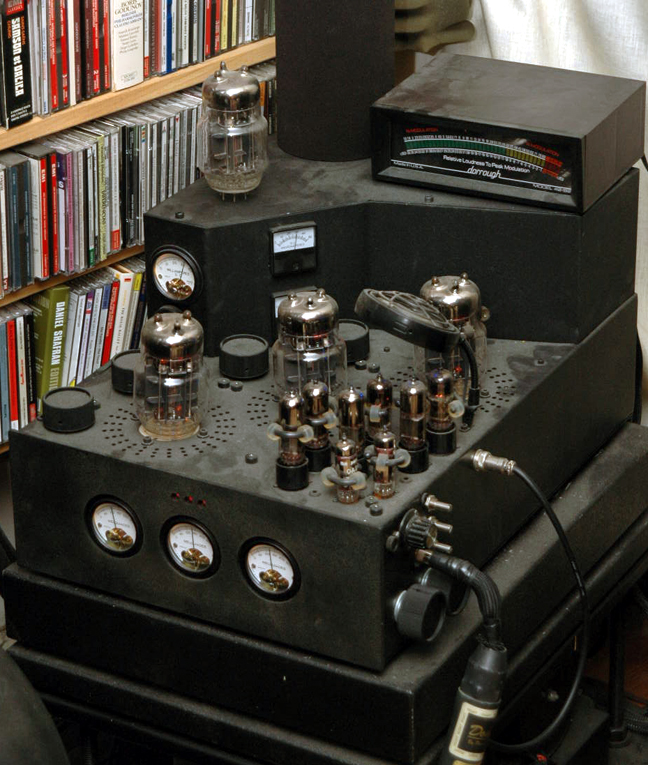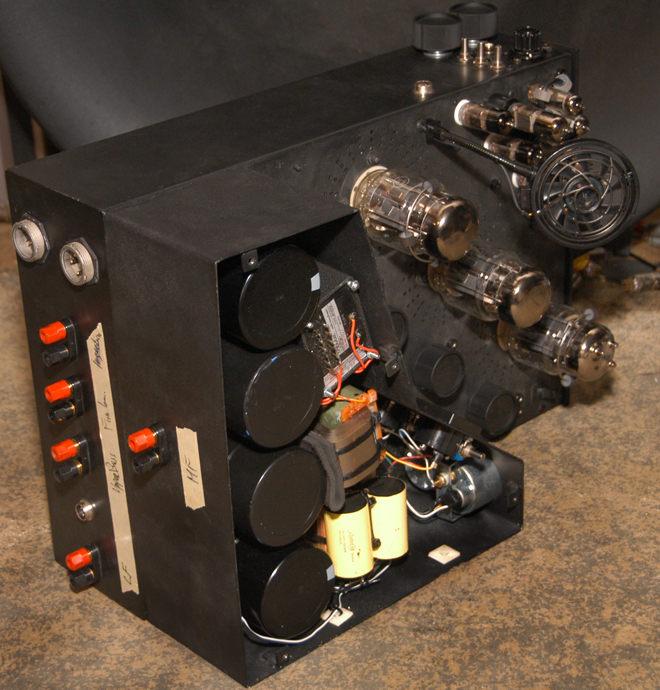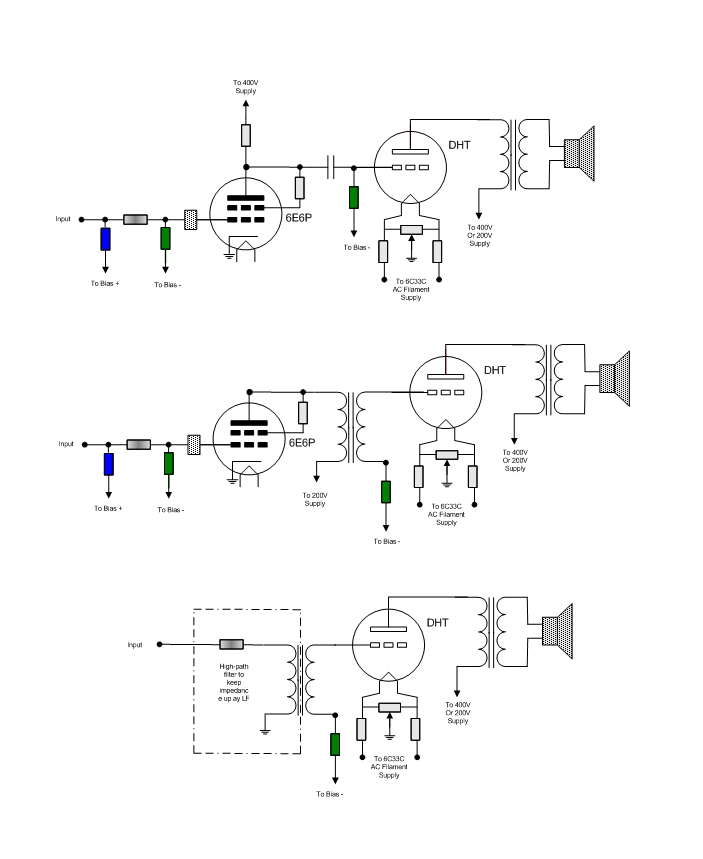Rerurn to Romy the Cat's Site
In the Forum: Melquiades Amplifier
In the Thread: Single-stage Melquiades vs. DHT amps
Post Subject: My DHT experiment: some conclusions.Posted by Romy the Cat on: 11/30/2008
fiogf49gjkf0d
Ok, I do not know what it was: was it DHT, was it 300B, was it some other specifics of this given amp or whatever… but those two aspects that I named: intentional density of colors and randomness of pace are something that I would like to exercise in my playback. However, I am not one of those who give away a store and I have no interests to lose what I have accomplished (like superb clarity, cleanness, dynamic, articulation without “resolution” etc) and recognize as my Macondo’s current virtues in order to pursue for what DHT might (or might not) add to it. In case of the density of colors it means that would not mind to sprinkle some additional color upon the sound of my MF driver but I disagree to lose anything in the driver’s contrast, color impartiality, tonal discrimination, dynamic discrimination, transients, speed and energetic willingness.
So, what I am talking about is ability for an amp to have some kind of inner-algorithm that dynamically and actively “color” or better to say “dye” signals, still maintaining general color-neutral tendencies. Since I kind of formulate this concept in my head I would like to name it and will refer it in future as Active Pigmentation. The Active Pigmentation implies that a channel expresses a slightly over-saturated tone but only under as a specific dynamic or pitch conditions. The depth and the conditions of the saturation shell be manageable. The readers who read my site carefully would ask: “Romy, are you talking about the idea of Macondo’s Injection channel only by electronics means. The answer is “Exactly!” Let submerge together into the insane world of deep-core audio drilling…
Pretend we have an abstractedly-neutral and high-performing, clean channel (let for a cause of illustration it to be S2) driven by a neutral and high-performing amp (let for sake of illustration call it single-stage Milq). Now, how can I inflict the Active Pigmentation of the Milq sound particularly if the amps like Milq have no parts in it? Even if it had then the passive parts would proves only static and hardly manageable coloration – I need Active and controlled coloration. Well, the solution might sound idiotic but no more idiotic then the idea of my Macondo’s Injection Channel. Still whoever had the experience how I implemented the Injection had no downs that it is not just works but works astoundingly well.
So, what I propose? Well, it is not what I propose but rather the idea was born when Dima and I discussed the results of my DHT trip. I was asking about design of harmonic correction circuits and was inquiring if it is possible to inflict by will the specific coloration to the specific harmonics. We were thinking about different methods and then Dima asked: if to run a DHT in parallel with Milq, mixing their currents, then what would happen?
OK, let go from here. How about to put right on the Melq’s MF anode supply another tube running it in parallel with Milq’s tube, let call it the Injection Tube. This Injection Tube is some kind of DHT similar to 10Y, 24, 27, 45, 50, VT-25, 2A3, 6B4G, 300B, AD1, AZ1, 6A3, 210T and alike. Furthermore the DHT in voltage starvation mode, uses heavy colored coiled cathode bias and has operating point that yields a lot of distortions and a lot of colorations. A resistor in cathode is adjusted to regulate the plate current and to drive the B+ hungry tube even deeper into colorations. The signal of the Injection Tube is driven across the same output transformer but at much lower current. Let say the main Milq’s tube push 30mA and the Injection Tube pumps 5mA. Adjusting the balance between the Main Tube current and the Injection Tube current it is possible (???) to moderate the necessary Pigmentations. What I outlined is just a concept not the model to follow. If it works then the currents of Main and Injecting tube might be mixed by many different ways: with own DHT transformer at speaker level, with dedicated separate coil on the main output transformer or by many other ways. It might be even fun to drive the cathode resistor of injection tube with some kind of reversed feedback from the main amp. The main tube will serve the main “shape” of the sound and the injection tube presumable will add the right amount of MSG to total sound.
What I describe not what I am trying to do but I am thinking about it. I need some kind of very colored DHT tube or perhaps some kind of other method to crate my active “electronics syrup dispenser”. I consulted with a number of DHT minded people and they all feel that they know how to get out of their DHT the “neutral sound” but they are not sure what DHT would be the most “colored”. I presume that by barbarically starving the tube all of them turn into Tannoy Red (also the lower voltage will make the expensive vintage tube to live forever). Still, I would need some consulting from outside by somebody who played with objectives of non-neutral amplification or with sound effects made by analog means. Ok, it was what I was thinking about the DHT’s density of colors. What I am thinking might be a bit awkward from a perspective of common audio wisdom and it is possible that it might not work, or course more problems than solutions. Still, I find this direction is very much worth to explore. If somebody who has ears, brain, is comfortable with tube designs and would play with ideas of Active Pigmentation then please let me know about your findings as at this point it is not at my radars. As far as the pace randomness - I have no definitive thoughts. It might be the specifics of the given DHT amp, might be the amps power supplies or the specifics of this amp’s drivers. That DHT amp that I had used feedback, perhaps some specific aspects of the feedback application made it happen. I do not know and I continue to think about it. If someone has any proposals where the DHT randomness come from then let me to hear them.
There is an alternative thinking – why not to put in the 6-ch Melquiades one more channel with DHT and to drive with it my MF driver. It might be possible that being implemented “better” and properly loaded the same 300B for instance will not eat dynamic and articulation and will sound “clean”. Ironically the idea to add a DHT section to Milq it very simple to execute. I do have a good spot for the DHT tube: right atop of the amp (I put there now one more 6C33C)

This is very good location as if has no limitation for heat dissipation and the MF output transformer is right there under the top cover

The Milq has inside the chasses a good quality 400VDC and 200VDC and to suck more plate current for DHT would not be a problem. The single-stage 6E6P of the MF channel will become a driver but instead of driving the output transformer it will drive the DHT tube. The Milq has inside bias voltage and anything else that is necessary. There are two types of DHT – with amplification of 7-8 and 4K-7K of plate impedance and those that have sub 1000R plate impedance and amplification factor of 3-4. If I use the second type then I might use my current 15:1 output transformer from 6E6P, at least for start. All that I would need is a little filament transformer with a center tap to drive the DHT or even do not do it and to burn the extra voltage of 6C33C heater in power resistors. This might be a very simple modification and theoretically if to have a good quality 10-poll switch then it is possible to make the MF channel switchable even in real time from single-stage 6E6P operation to a two-stage DHT operation. The entire Milq MF DHT channel might be look like this in case a IDH driver was used:

So, do I consider doing it? At this point not. You see, I do not really know if I might need it in term of a practical result. Reading my comments in the “Observations” post and my comments about the ”differences” when the amps drive the MF driver only one might think that the ”differences” are observable via the sound of the whole Macondo. Well, I am not sure about it. What now Milq and Macondo do is good in my view, and I do not experience a need to change it even though I did acknowledged the ”differences”. If I need to do anything is to learn if the DHT’s differences would be tangibly beneficial just for MF driver and in context of the whole Macondo Acoustic System. To learn it I would need a PROPERLY-made DHT amp (without all stupid tricks of static colorations) where I would have a chance to play with loading, damping, perhaps the core of the output transformer, currents , the character of sound and where I would make sure that the MF does what I need it to do. Macondo is not a full-range driver and all aspects of Macondo ingredients shell be thought together. I have a failed Melquiades for headphone amp that I might easily retrofeed with second DHT stage. I do have also some OPT what I might try. All that I need to buy the DHT tube and the tube socket. I might also run the test from my lab power supply; I have a very cool old whole tube Fluke 709D. Perhaps I will do but I would need more encouragement that it might make sense and would not lead just to another stupid DIY project but rather to a sensible improvement of sound. When for a very short time I connected this DHT that I have last weekend to MF channel and ran it along with the rest of Macondo honestly did not see any needs for me to change anything. It was very short and I might be wrong. Perhaps another DHT amp will come my way and I might study this subject deeper.
I did have an educational and thoughts provoking experience with this DHT journey. I do not think that the exploration of this subject is over. Let see what future will bring.
Rgs, Romy the Cat Rerurn to Romy the Cat's Site